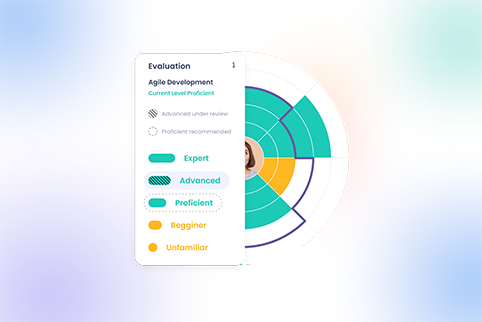
Welcome to the new world of work, where predictability is a thing of the past, and having an agile workforce is quickly becoming the key to success!
We’re witnessing disruptions at all levels, from the way we work to the tools we use, and cutting-edge technological advancements are only accelerating the pace of change. Just take a look at ChatGPT and other generative AI tools that are already transforming the work environment and shaping the future.
In this fast-paced, ever-changing business world, organizations can’t afford to stay static. To remain competitive and thrive, they need to become more dynamic, adaptable, and flexible. That’s where building an agile workforce comes in.
In this article, we’ll dive into the importance of creating an agile workforce, the benefits it brings to organizations, and the essential steps you need to take to make it a reality.
But be warned, it’s not an easy path. There will be obstacles along the way, and we’ll explore those too. So, buckle up, and let’s get started on this journey to building an agile workforce!
Why developing an agile workforce is important
To stay ahead of the curve, creating an agile workforce is crucial for businesses. This type of workforce allows for quick movement of people, assembling and disassembling teams rapidly, and identifying and responding to new opportunities.
How does this workforce achieve such feats? Thanks to the inherent characteristics of agile workers and teams:
- They have multiple transferable skill sets
- They embrace new challenges and possibilities
- They are open to experimentation and learning from mistakes
- They see learning as a continuous life-long journey
Studies have already shown that agile companies outperform their competitors and adapt faster to market demands and customers’ expectations. According to McKinsey, the main outcomes of successful agile transformation include:
- 30-50% improvement in operational performance
- 20-30% boost in employee engagement
- 10-30% increase in customer satisfaction
What are the benefits of an agile workforce?
Embracing and nurturing workforce agility impacts both organizations and their employees in significant ways. And the advantages cannot be dismissed. Here are some of the main ones that will make you consider shifting to this approach:
1. Faster response times and adaptability
An agile workforce can easily adapt to changes in the market, technology, and customer expectations, which is critical for staying competitive. For example, companies that were already working remotely before the pandemic had a much easier time in the last years and were less affected.
Looking towards the future, it’s easy to see how workforce agility will allow employees to transition faster to different roles, master new tools, and be overall more efficient.
As for the speed of response, it remains a critical factor in the highly competitive business market. Waiting too long to respond or allowing others to make the first move can spiral down in more ways than one. It’s enough to look at companies like Nokia and Blackberry, who, at the time, didn’t see the iPhone as a threat and eventually paid the price.
2. Driving innovation
A company can improve its innovation capabilities by leaving the top-down mentality behind and fostering a culture of experimentation and learning. Through an agile mindset, employees are encouraged to take risks, try new things, and learn from their mistakes, leading to more innovative and creative solutions.
For example, apps that allowed people to use their smartphones as cameras for their computers already existed. But do you think a tech giant like Apple would have come up with innovations like Camera Continuity (use your iPhone as a webcam for Mac) or Centre Stage (keep people in the frame during calls) before?
It’s a perfect example of external factors combined with internal creativity to drive simple but effective innovation.
3. Improved customer satisfaction
Businesses prioritize customer satisfaction, but it can be difficult to achieve it at high levels during times of change, uncertainty, or economic downturn.
An agile workforce can be helpful in these situations. That’s because it can easily adjust its priorities and strategies to meet the evolving needs of customers. This ensures that the organization understands people’s needs and can provide relevant and helpful products and services.
It also allows people from different departments, which aren’t necessarily related to sales or products, to come up with feedback and different points of view. This larger pool of ideas and insights is an excellent way to make sure nothing is overlooked when it comes to customers.
4. Higher employee engagement and retention rates
Agile workers are more engaged because they have a say in the projects they work on, are part of a dynamic team, and feel more fulfilled by their work. They also relish the opportunity to work across a wider variety of projects, which gives them the chance to develop new skills and network with their peers.
Combined with the possibility to make lateral or vertical moves within the organization, workforce agility will keep employees satisfied and inspire them to craft their own dream careers, which is a win-win for everybody.
5. Increased productivity
By assembling and disassembling teams quickly, an agile workforce can tackle projects more efficiently, leading to an increase in productivity and performance.
This is possible thanks to projects and tasks being elaborated and assigned with a skills-based approach in mind. Whoever possesses the right capabilities and know-how can join and help deliver the right solution and better results.
With workforce flexibility, it is no longer about job titles and fixed responsibilities. But rather about allowing everyone to contribute with their own unique abilities and talents.
How do you build an agile workforce that’s ready for the future?
Creating an agile workforce with a skills-based approach takes careful planning and alignment between business objectives and talent management strategies based on people’s potential.
Let’s take a look at the most important steps you need to take, starting with:
1. Transition to a skills-based approach
Traditional hierarchical structures and rigid top-down cultures don’t mix well with workforce agility and flexibility. To make this shift, leave behind the traditional static job roles as the foundation for your talent decisions and look instead at more dynamic skills-driven approaches that highlight people’s potential:
- Define (present and future) business needs and identify critical skills
- Create a skills matrix to understand the current abilities within the company and discover any skill gaps
- Define skill and proficiency levels for each task, project, and role
- Determine the type of opportunities you’ll make available for skill development and coaching
- Make skills, requirements, and opportunities transparent to everyone within the company
The process will empower your people and allow them and their leaders to choose and assign projects based on each person’s capabilities. This will also increase the diversity of tasks, reduce stagnation, and encourage a growth mindset.
2. Adopt talent marketplaces & talent sharing
Internal mobility is one of the most powerful ways to help your workforce and organization at large become more agile. By embracing talent-sharing practices, you allow employees to move fluidly within your organization and take assignments or projects according to their career passions and skills aligned with your business needs.
Through a talent marketplace, organizations can make all the opportunities visible at once and connect their employees with various internal projects, like gig work, short-term assignments, new job roles, or mentorship and development programs.
Talent marketplaces enable organizations to leverage the diverse skills and expertise of their workforce, fill skill gaps, and improve project outcomes. The focus is on creating cross-functional teams and aligning opportunities with people’s capabilities, interests, and potential.
3. Enable personalized development opportunities
It’s a common practice to allocate a specific development budget or learning platforms to each department or position. However, this approach is inherently limiting and doesn’t support the growth of workforce agility.
Just like tasks and projects, learning opportunities should be transparent and personalized according to each individual’s unique set of skills and interests and aligned with the organizational goals.
Otherwise, organizations can miss out on the full potential of their workers, who can leverage these development opportunities to grow their knowledge and skills and drive even more business impact.
4. Integrate it into your work culture
While policies, systems, and tools can help, they won’t be enough to build an agile workforce. You need to make this new way of working a part of your organizational culture, a part of your values. To achieve that, you should encourage your employees to:
- Embrace collaboration and experimentation
- Shift from a fixed to a growth mindset
- Make ongoing learning the default
- Focus on their future, potential, and interests and make room for them to experiment different career paths
This can take some time and it’s not about targeting immediate results. But rather planting the seed of this new approach and ensuring it grows steadily and matures into an effective business solution.
What are the challenges of building an agile workforce?
The main obstacles you’ll need to overcome are directly related to some of the steps listed above. So, let’s have a quick look at what you may need to overcome:
1. Difficulty in identifying the right skills
Switching from jobs to skills, mapping out skills, and identifying relevant gaps can become a complex task. It’s essential to start small, perhaps with only one or two teams or departments, and track the results. This is where the role of technology comes in.
A platform that enables skills management can highlight your workforce’s existing skills, align them with roles, and identify any skills gaps before turning critical.
This is just one of the many features provided by Nestor’s People Intelligence Platform.
2. Resistance to change
Shifting to an entirely new way of structuring and doing work won’t be easy to accept for everyone. Especially with people suffering from change fatigue thanks to everything that has happened during the pandemic (and after).
You can expect, at least from some employees, to show resistance to:
- New practices and procedures
- Collaboration and cross-functional operation
- Experimentation and failure
- New platforms
How much resistance you’ll encounter depends on the levels of flexibility in your organizational structure. But the best way to address it is to implement changes gradually and transparently.
At the same time, collaborate with HR leaders and people managers, who have won the trust of their team members and can explain why these changes are meant to empower growth and efficiency, not to limit anyone.
3. Uncorrelated development opportunities to organizational goals
This cultural shift and the transition to an agile workforce will require additional investment in new platforms and tools, especially in identifying the right learning and development opportunities that can lead to growth and better business outcomes. In practice, as shown by data, 84% of organizations don’t offer employees development opportunities aligned with organizational goals. (Josh Bersin Academy 2022).
The Nestor platform supports organizations to close the gap between performance and development goals by helping people managers and their teams identify and assign the best-fit development opportunities that could drive organizational success.
4. Higher risk of overload
It’s easy to get excited about the benefits of workforce agility, but it’s important to be aware of the potential drawbacks, such as higher chances of overload and burnout among employees.
Talent sharing can lead to regular and top-performing employees juggling multiple high-importance projects simultaneously, which can become stressful and draining in the long run.
Just because someone has the right skills for a task doesn’t mean they should do it. It’s crucial to monitor workload planning and regularly conduct pulse surveys to check overall employee sentiment and well-being.
How Nestor can help you nurture an agile workforce
Here at Nestor, we are passionate about the future of work and believe that skills and skill-based approaches are the way forward.
Our People Intelligence Platform is the ideal tool for identifying current and future skill needs, increasing cross-functionality, and enabling talent mobility. With employee skills profiles and personalized growth opportunities, our solution is the perfect partner for organizations looking to achieve talent optimization and make the transition towards a more modern and future-proof agile workforce.
Unlock the full potential of your workforce and let’s reshape the future of work together!







